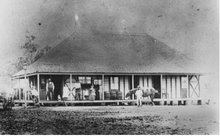Driving east to Plainlands today (which was presumably named after the flat land in the valley and not for its lack of scenic amenity) I drove past Hattonvale. Most of the buildings there are away from the highway, but I am always struck by the incongruity of a cathedral-like church rising from the paddocks.
Most local churches here run to weatherboard exteriors with the occasional exuberance of a small square tower. Many are simply wooden open-plan rectangular halls built up on stumps like many of the houses here. One exception is a beautiful tiny stone church in Ma Ma Creek. The other is the Apostolic Church of Queensland at Hattonvale which combines a historic church with a modern architectural prize-winning extension.
On moving to the area, I made enquiries as to what manner of church this was. Most people had no idea. One ventured “some kind of high church Lutheran.” Until now, this has been all that I have known.
I do know that it has been a centre of German social life for some of the area’s founding settlers so I decided to investigate further. They have a very informative website, outlining their theological beliefs and some of their history.
One reason I am interested in this church, other than the incongruity of its location and architecture, is that Apostle H.F. Niemeyer was involved in bringing hundreds of German migrants to Australia. He also arrived in Australia around the time in which I am interested.
As far as I can tell without theological training, the distinguishing beliefs of the Apostolic Church of Queensland (a church fully contained within Queensland and largely in this area) are the belief that God has continued to appoint apostles to bring special teaching to the church and the idea of being “sealed as a bride of Christ.” As far as I can understand, this means being given the gift of the Holy Spirit through laying on of hands by an apostle. This sealing is seen as one of the sacraments in addition to communion and baptism.
With strong links to English and Scottish Catholic apostolic movements, the ideas of this church developed in the 1860s in central Germany. The church founders welcomed the Prussian success, because their persecution was lessened as the power of the state church waned in the new political climate. The church is now linked to apostolic churches, in the Netherlands, Germany, Switzerland and France.
Apostles are not paid by the church and are expected to earn a living as “brothers among the brethren.” Apparently this combination of religion and a strong work ethic is a good one judging by the cathedral.
I am not so much interested in the church itself, as I don’t imagine the Jaeckels would be involved with a group that welcomed the Prussian takeover, however, Niemeyer’s experiences in early Queensland may be informative. More to come …
Thursday, 19 April 2007
A diversion through architecture and theology
Labels:
Apostolic Church,
churches,
German migrants,
Hattonvale,
Prussia
Subscribe to:
Post Comments (Atom)

No comments:
Post a Comment